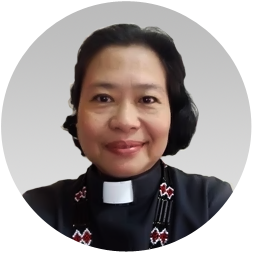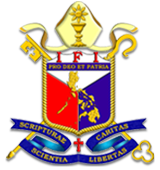All Soul’s Day Reflection

From ancient times, the practice of honoring the dead was a communal response. It becomes part of the tradition of the people, of their culture. From taking care of the dead body to its burial complete with a certain ritual were significant events observed. Other ancient civilizations have different practices and rites like the extent of ceremonies done differs of who is the dead person: a king or person with authority or an average one or a slave. It is like: special or ordinary service to some churches today (with varying amounts).
The Eastern Orthodox and Byzantine Catholic Churches have Saturday of Souls (or Soul Saturday) as a day set aside for the commemoration of the dead within the liturgical year. Saturday is a traditional day of prayer for the dead, because Christ lay dead in the Tomb on Saturday. But as far I can remember in my home parish, Monday is set aside for Memorial Masses or services for the dead. Our priest wore a black cassock. It is similar also to some parishes in Mindanao.
The institution of a day for a general intercession on November 2 is due to Odilo, abbot of Cluny (died 1048). The date, which became practically universal before the end of the 13th century, was chosen to follow All Saints’ Day. Having celebrated the feast of all the members of the church who are believed to be in heaven, the church on earth turns, on the next day, to commemorate those souls believed to be suffering in purgatory. No wonder priests celebrate mass wearing vestments of varying colour—black (for mourning), violet (symbolizing penance), or white (symbolizing the hope of resurrection). And this is predominantly the view especially the Roman Catholic Church because they believe about purgatory. The concept of purgatory is dated back to medieval Christian and Roman Catholic beliefs where the condition, process, or place of purification or temporary punishment in which the souls of those who die in a state of grace are made ready for heaven.
It is a kind of understanding that since you have not perfected your earthly life, the souls have a place to stay purifying from sins prior to the heaven’s entry. However it was absurdly use before even use abusively. That an unlawful person has to pay his sins and he is absolved or pardon by the Church: Roman Catholic in Rome. Subsequently, Martin Luther included in his Ninety-five Theses, propositions for debate concerned with the question of indulgences. It was known that he posted on the door of the Schlosskirche (Castle Church), Wittenberg, on October 31, 1517. This event came to be considered the beginning of the Protestant Reformation on Oct 24, 2020. How the priest knew one is sinful or committed sin? It was through confession.
Influenced by the Roman Catholic practiced, the IFI clergy does the same in conducting memorial services in different dioceses. To date the IFI has yet general conduct to follow with regard to the vestment. However, our diocese had made a unified stance on this matter. When the current Obispo Maximo was the Diocesan Coordinator in our Diocese, he was instrumental for a Diocesan Action to use white vestment for the dead. The explanation is more theological. Jesus died and resurrected. A baptized person who already received salvation, when the person dies, surely the soul will go and join in heaven, back to the Creator without a stopover in the purgatory. Because we believe that the soul of the dead person has no other place to go but to be homed with the Creator God. Some churches have another understanding, like: when a person dies, the soul separates. That is the end of the body and the soul connection. When the soul separates from the body, the soul will go back to the Source. End. Period. No more commemoration.
Honoring the dead is very significant in celebrating one’s life. It is also a thanksgiving of the life bestowed by God. To other countries it is a long holiday like in South Korea where Koreans have to find ways to go home, to pay homage, and respect for the dead. But majority of Koreans are not Christians like the Chinese but their homage to the dead is different. There are still practices like dead worship. In the Philippines, it is no longer a holiday unless it falls between working days. Like other countries, Filipinos take leave from their works to pay respect to their departed love ones as well. If it is not of pandemic, surely since last week hundreds of people were queuing in bus terminals, sea ports and airports and other accessible transport just to go home. However our practices varied on the observance for the dead.
During childhood to adolescent, I remember my mother prepare some foods as offering and special candles for the departed to be brought to the cemetery and made sure the priest would not miss to bless the tomb. I was always the lookout. In our home altar, pictures of the departed were arranged and made it sure the foods in smaller containers were offered. There were wine, soda and fruits even desserts. All the family members were together during a brief ritual and prayers for the dead. Afterwards, we ate together as in celebration. To date, we never had a Halloween related activities prior to November 1 and 2 and my understanding it was all about All Soul’s Day. All Saint’s Day was only introduced to me during seminary days.
I am not against of those practices like blessing the tombs in the cemetery being part of the tradition, like our Parish Priest did and my family. Since seminary I had never done cemetery blessing except one in Urdaneta (we were at ACTS before), there was a need for priests.
In my assignment in Misyon ng Birhen Balintawak, I explained to the congregation what is significant and meaning of All Soul’s Day observance, wearing the white vestment and its relation to tombs blessing. What is important was the celebration of the Holy Eucharist in memory of our departed love ones. No need to rush to the cemetery to light candles without having a Mass. So everybody must attend the early morning Holy Eucharist for All Soul’s Day in the church, read all the names of the departed ones (burned written names), bless the candles and let the congregation went to the cemetery after the Mass. There is no need to bless the tombs. Once I went with the youth at the Loyola Memorial Park but only to see celebrities. Well,
I do not know after I was transferred to Krus na Ligas Mission for more than a year and was moved to UP Parish of the Holy Cross. I continue the All Soul’s Day Observance every November 2. I wore white vestment (never done with other colors) and the ritual of burning the written names of the departed. Something will be different this All Soul’s Day, for during the lockdown we only have the greens, ornamental plants from the churchyard to offer or the flowers from the front yard.
What is the significance of All Soul’s Day to me? Before it was simply a special general/universal observance for the dead where the family were together, lighted candles on the tombs of the departed love ones and blessing the tombs and to offer foods. Now its significance is more on thanksgiving of the life bestowed by God and celebrating life, honoring our departed loves ones and asking God for continual blessing of their souls. Being a priest, though this is a regular rites of the church but leading the faithful honoring respect for the departed souls and thanksgiving of the life God breath unto them through the celebration of the Holy Eucharist is a humbling act and awe-inspiring experience.
Nota Bene:
I used the Liturgy for the Dead ascribed by the IFI. But I kind of inputting some innovation and creativity to the liturgy. When I need a special liturgy for the dead like in English, I search the net but retain what is IFI.
Thank you!


